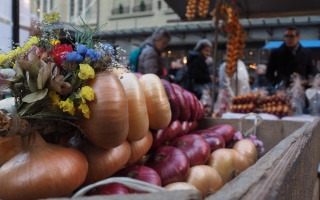Colorful market stalls offer ceramic pots, bread, vegetables and mementos to the visitor. To help resist the winter cold, don't miss the Glühwein stand. The bustle starts early in the morning and hundreds of visitors from home and abroad stream through the town. This is the day when cheese, cheesecake, onion cakes and onion soup are on offer in all the restaurants, giving off a spicy aroma. Younger visitors scatter confetti in the streets, and have fun at the fairground.
Modern Myth and Ancient Fact
Shortly before five o’clock on the afternoon of 14th May, 1405, fire broke out in Bern’s Brunngasse. Within the space of a few minutes, fanned by a strong wind, the flames had spread across to the opposite bank of the Aare river. In neighbouring towns collected money and sent helpers. Most admirably of all, over a period of two months the citizens of Fribourg, led by their alderman N. Gambach, helped clear away the debris and displayed great honesty by handing in all items found in the process.
At this point the tale audaciously takes on mythical proportions, as first told around 60 years ago in the schoolrooms of the City of Bern. According to this version, as an expression of their gratitude, the Bernese granted the citizens first Zibelemärit was held in 1406. Yet in the chronicles of Conrad Justinger, who was witness to the fire, there is no mention of this grant to sell onions. Indeeed, it would have been a poor expression of thanks! Just where the hundreds of Fribourg helpers, all city-dweller, supposed to get hold of onions for an annual market? At that time, there was no extensive growing of one particular crop in the region. Moreover, the Bernese grew vegetables themselves behind their houses. And if the yield was insufficient, they could always buy onion at the weekly market in the Zibelegässli (Onion Lane).

The Zibelemärit actually began much later. In the 18th century, farmers’ wives brought the vegetables they had cultivated on Mont Vully above Lake Murten to markets in Fribourg, Murten and Neuchâtel. Around 1850, at first almost unnoticed, these so-called "marmettes", began to turn up in Bern on the first day of the city’s ancient two-week Martinmas Fairs, selling primarily onions but also endives, leek, celeriac and black sasify, nuts, chestnuts and fruit. Thanks to the excellent quality of the produce and the cheerful, friendly demeanour of the farmers’ wives who sold it, the new vegetable market rapidly blossomed until, as early as 1860, newspapers were proclaiming the Zibelemärit as the "traditional" start of the Martinmas Fair.
So the establishment of the Zibelemärit was linked to the much older Martinmas Fair. And how did the Fair itself originate? Since the late Middle Ages - long before the fire of 1405 - citizens of Bern and other residents of Switzerland’s southern German-speaking regions had celebrated the changeover from the summer half-year to the winter half-year on Martinmas or St. Martins’s Day, with festive meals, processions and torchlit parades in which the younger citizens played a noisy and enthusiastic part. The festival was accompanied by a busy weekly market which mainly sold goods for the coming winter and, due to its various attractions, gradually grew in popularity until in 1439 the authorities officially declared a levy-free Martinmas Fair to last several days. Bern was also granted an Easter Fair in the same year.
In the course of the present century, large department stores have gradually superseded these traditional market fairs. The Easter Fair disappeared after the Second World War, and only the first day of the Martinmas Fair (the fourth Monday in November) is still celebrated - with the Zibelemärit. However, some medieval Martinmas customs survive to this day: notably the festive meals featuring cheese and onion pies, and the wild antics of the younger population in Spitalgasse. Only the torchlit parades have disappeared. Moreover, the two-week annual market at Easter and Martinmas are still a lively tradition.
Date: On the fourth Monday every November
Locality: Old Town
